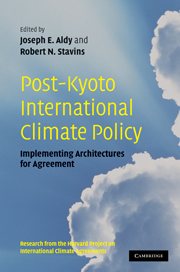Book contents
- Frontmatter
- Contents
- Harvard Environmental Economics Program, International Advisory Board
- Harvard Project on International Climate Agreements, Faculty Steering Committee
- Harvard Project on International Climate Agreements, Project Management
- List of figures
- List of tables
- List of contributors
- Foreword
- 1 Introduction
- Part I Alternative international policy architectures
- Part II Negotiation, assessment, and compliance
- Part III The role and means of technology transfer
- 13 International climate technology strategies
- 14 Mitigation through resource transfers to developing countries: expanding greenhouse gas offsets
- 15 Possible development of a technology clean development mechanism in a post-2012 regime
- Part IV Global climate policy and international trade
- Part V Economic development, adaptation, and deforestation
- Part VI Modeling impacts of alternative allocations of responsibility
- Part VII Synthesis and conclusion
- Appendix A Selected List of Individuals Consulted, Harvard Project on International Climate Agreements
- Appendix B Workshops and Conferences, Harvard Project on International Climate Agreements
- Glossary and Abbreviations
- Index
14 - Mitigation through resource transfers to developing countries: expanding greenhouse gas offsets
Published online by Cambridge University Press: 05 June 2012
- Frontmatter
- Contents
- Harvard Environmental Economics Program, International Advisory Board
- Harvard Project on International Climate Agreements, Faculty Steering Committee
- Harvard Project on International Climate Agreements, Project Management
- List of figures
- List of tables
- List of contributors
- Foreword
- 1 Introduction
- Part I Alternative international policy architectures
- Part II Negotiation, assessment, and compliance
- Part III The role and means of technology transfer
- 13 International climate technology strategies
- 14 Mitigation through resource transfers to developing countries: expanding greenhouse gas offsets
- 15 Possible development of a technology clean development mechanism in a post-2012 regime
- Part IV Global climate policy and international trade
- Part V Economic development, adaptation, and deforestation
- Part VI Modeling impacts of alternative allocations of responsibility
- Part VII Synthesis and conclusion
- Appendix A Selected List of Individuals Consulted, Harvard Project on International Climate Agreements
- Appendix B Workshops and Conferences, Harvard Project on International Climate Agreements
- Glossary and Abbreviations
- Index
Summary
Introduction
Both developing and developed countries hold a central view in common in international climate negotiations: each thinks the other should be doing more to mitigate greenhouse gas (GHG) emissions. To date, international negotiations and agreements on climate change have not been particularly successful in creating significant changes in either the commitments or actions being adopted by developing countries with respect to GHG mitigation. Our proposal in this chapter is to build on existing offset policies to enhance efforts by developing countries to combat climate change.
For a variety of environmental and political reasons, focusing on developing countries is crucial at this stage in the climate regime's evolution (Frankel 2007). Most obviously, large developing countries —especially India and China—account for an increasingly important share of global emissions as a result of rapid population and GDP growth (Stern 2007: 169). The International Energy Agency forecasts that three-quarters of the increase in global energy use over the next two decades will come from developing countries (IEA 2007). A successful climate architecture will have to include mitigation in these parts of the world. At the same time, the world's largest emitter, the United States, has made participation in binding emissions reduction contingent on actions by large emitters in the South. Thus developing country participation has emerged as the lynchpin of progress in global climate negotiations.
One possibility is to encourage developing countries to participate by assuming mitigation commitments, just as their richer counterparts do. While this is a potentially viable strategy in the long run, it is unrealistic and not essential in the short term.
- Type
- Chapter
- Information
- Post-Kyoto International Climate PolicyImplementing Architectures for Agreement, pp. 439 - 468Publisher: Cambridge University PressPrint publication year: 2009
- 2
- Cited by



